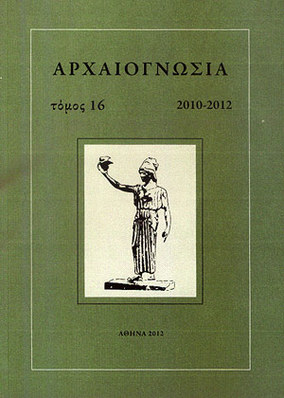Το επίγραμμα από το μνημείο του Ιουστινιανού στη Χερμέλα (Khirbet el Karmil) παρά την Χεβρώνα Παλαιστίνης
Part of : Αρχαιογνωσία ; Vol.3, No.1-2, 1982, pages 223-228
Issue:
Pages:
223-228
Parallel Title:
An epigram from the momument of a certain Justinian found in Chermoula (Khirbet et Karmil by Hebron in Palestine)
Section Title:
Σύμμεικτα
Author:
Abstract:
This metric epigram is inscribed on a white marble slab and served as an inscription on a tombstone. The inscription which is kept today at the Rockeffeler museum in Jerusalem comes from Khirbet el Karmil by Hebron. It was found in nine pieces in the hands of grave robbers a short time before the six day war in 1967, was confiscated by the Jordanian authorities and handed over to the Department of Antiquities, the restorers of which put all the pieces together and placed the inscription inside a wooden frame. The inscription measures 0,285m height, 2 meters width and 0,035m thickness, height of letters 0,030-0,050m. My application to study and publish the inscription was kindly approved by Mr. A. Eytan, the director of the Department of Antiquities and Museums of Israel in 1981.The epigram was written in oval capital letters by a professional engraver. The text was divided into two parts by a vertical line, each part stressing a separate thought. This was the reason which guided me to number the lines of each part separately. Several mistakes were committed during the execution of the work by the engraver who did not understand the text he was copying. In order to read correctly the epigram I had to consider the following mistakes and read... τενξε μενοινη instead of... τεΰξεν έν οί'νη in line 2 of the first part, Αΰγην instead of Αυτήν in line I of the second part, Μουσών συνδοιάς instead of Μουσών ούν δοιάς in line 2 of the second part and also to complete the missing letters in line 4 of the first part and in lines 3 and 4 of the second part.The epigram in its first part tells us that a certain Justinian, who lived vitruously knowing that life must come to an end, wisely built a family tomb in the hope and wish that this tomb would receive the older members of the family first. In the second part the epigram praises and glorifies two maidens, Pancharia and Auge, already buried in the tomb. They were graceful, virgins and vitruous like the Muses. Their mother was Prisciane and their father Justianianus (the tragic father who built the tomb).As the inscription was found out of its archaeological context (pottery, coins, architecture, human relics etc.), the indispensable elements for a terminus post or ante quern for an undated monument I placed it approximately to the period between the 3rd and 4th century A.D. considering the following factors: The lack of Christian elements, lack of abbreviations, the restrained sorrow expressed in the epigram, characteristic to the ancient Greek world in facing death, the type of letters and the hypothesis that this certain Justinianus belonged to the garrison of the “équités scutarii Illyriaci”, who settled in the area after the reforms of Diocletian of 284-305 A.D.This magnificent metric epigram in homeric language and with pure Greek as well as hellenized Roman names, gives us an idea of the presence of Greeks and the use of Greek on the countryside of central and mountainous Palestine during the late Roman period.
Subject (LC):
Keywords:
επιγραφές, ρωμαϊκή περίοδος, Παλαιστίνη




